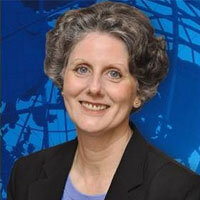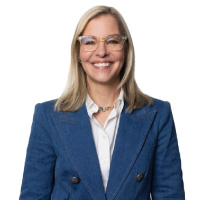In this discussion, Lynda Stadtmueller from Frost & Sullivan interviews Keri Gilder from Colt Technology Services, shedding light on the telecommunication industry’s shift toward software-defined networking, ESG (Environmental, Social, and Governance) initiatives, AI, and quantum technology in connectivity.
Frost & Sullivan’s Transformational Growth Leadership Program aims to honor visionary business leaders who possess the foresight and leadership acumen to drive positive change within their organizations.
What’s Catalyzing Transformation in Traditional Network Services
Lynda Stadtmueller: Keri, thank you for joining us today.
You’re in an industry that hasn’t been widely known for innovation for many years. What’s the difference now? What are the trends that are impacting network services and telecommunications?
Keri Gilder: There’s a lot to unpack in that question, so I’ll address it in two parts. First, our industry is not recognized for innovation, which is unfortunate. Over the past 20 years, there has been innovation, but we haven’t been good at communicating it. For example, Colt has developed an on-demand connectivity service like Amazon Web Services’ ease of use for cloud computing. Despite winning numerous awards, we haven’t promoted these innovations effectively, especially to young talent.
Another example is the recent rollout of quantum encryption on our networks, which is next-generation technology. However, we aren’t vocal about these advancements, and they aren’t widely discussed on platforms like YouTube, making it less appealing to the next generation.
While we have been innovative in some areas, we’ve missed opportunities in others, such as developing applications like WhatsApp. The telco industry has struggled with software development and transforming beyond physical assets (like fiber and copper). We excel at constructing networks but need to improve in software development as capabilities evolve.
Transformation is possible. However, it’s like moving a tanker ship—everyone needs to understand how to operate differently, without relying on physical mechanisms. This requires a mindset change, particularly around risk-taking. Our industry has grown up with a culture of near-perfect reliability, known as “5 nines” (99.999% reliability), which has made us risk-averse. This culture needs to shift to embrace transformation and innovation.
Embracing Software-defined Networking and Remote Operations
Lynda Stadtmueller: It’s been about five years since you became CEO. Can you share some of the key actions you’ve taken and the direction you’re steering the company in?
Keri Gilder: Over my tenure, we’ve faced waves of both opportunities and challenges. When I took over, we were in the midst of COVID, which was a unique challenge. For about two years, we managed the transformation of our business to be fully remote, and we also helped our customers transition to remote operations. It was a proud moment for our industry because we enabled the global economy and human connection when physical interaction wasn’t possible.
During this time, we saw a wave of transformation in software-defined networking. They say innovation often comes in times of crisis, and I truly believe that. People started thinking differently about their businesses and how they connect, moving away from physicality in many aspects, including software and networking. We saw a shift towards SD-WAN (software-defined wide area network) and increased security concerns, giving rise to software-defined security solutions like SASE (secure access service edge). Our legacy services began to decline rapidly.
This also brought new competition, with systems integrators entering our space. These companies didn’t rely on physical assets much, changing the competitive landscape. It became clear that maintaining status quo wouldn’t allow us to survive in future software environments.
We focused on creating self-serve environments for our customers and rethinking collaboration, partnerships, and solutions. As customer environments became more complex, we transitioned our sales arm into solution consulting, moving from simple connectivity to advisory solutions across the entire OSI (open systems interconnection) stack. This shift required us to become less risk-averse and more software-minded, driving transformation platforms and AI inference. I love that you mentioned telco as the original data owner. It’s still true—we are one of the biggest data processors and controllers. This means we have a huge responsibility to ensure data protection for our customers.
Fostering a Culture of Innovation
Lynda Stadtmueller: I want to delve into a couple of points about innovation. Frost & Sullivan considers Colt to be one of the most innovative companies out there, and I believe you have a strong legacy in this area. Many companies claim they want to be innovative but it’s challenging to achieve, especially in a risk-averse industries. How do you manage to foster innovation at Colt?
Keri Gilder: I believe the key is to recognize that innovation can come from anywhere. That’s probably the biggest lesson I’ve learned over time. Let me give you an example.
Think about the space shuttle launch. They faced the challenge of needing to reduce the shuttle’s weight by a few tons to get it launched. The engineers, who were supposed to be master innovators, were trying to figure it out. Then, a janitor walked in and asked, “Why is the shuttle white?” It turned out that simply removing the paint would reduce the weight enough to launch the shuttle. This illustrates that innovation works when you have an open mind and value alternate perspectives, no matter where they come from.
If you promote this mindset within your company, innovation becomes part of the culture. It’s about being open to outside perspectives, which is even more important as we move forward. The idea that you can put the five smartest people in a room to solve a problem doesn’t always work. That was the problem with NASA, they had the smartest people, but they were looking at it from a traditional engineering perspective.
At a previous company, we had a big issue on the sales side and couldn’t figure out how to drive growth in one area. During a conference, we brought in the lawyers, finance team, and everyone working on sales. We presented the problem in a workshop. Surprisingly, the team that solved the problem was the group of lawyers, not the salespeople.
Over time, I’ve learned that ideas and innovation often come from unexpected places. What makes Colt different is our diversity of thought, with people from 34 countries and 90% of our population speaking English as a second language. This diversity means we always have different perspectives coming in, and we naturally have to listen harder and better.
A growth mindset comes from being willing to open your mind to outside perspectives, truly listening, and not assuming you always have the answer.
Generating ROI From an Employee-first and ESG-driven Mindset
Lynda Stadtmueller: I love that. It’s a great segue into my next question. I wanted to ask you about Colt’s unique culture, which we at Frost & Sullivan believe is a significant value add and differentiator. Your inclusive and supportive culture among employees, as well as your efforts to be a good corporate citizen outside the company walls, are remarkable. Can you talk about that?
Keri Gilder: It really is. I feel that in this day and age, employees and customers matter. But employees come first. To have good customer experience, you need good employee experience. If you don’t have a solid foundation for your employees, no number of tools or processes will make your customer experience great. That’s the first thing to focus on.
Secondly, as the next generation enters the workforce, values matter more than ever. The old places of community, like churches and libraries, don’t play the same role anymore because people aren’t participating in them as much. This community aspect has shifted to corporations. We’re now looking for the values we present to the world and our employees. It’s not just about preaching these values but actually living up to them.
One of our values is that we believe we can change the world. When my team came up with that, I thought it sounded a bit like the Ten Commandments—too big for a small company like ours. But they said we’re changing the world daily by connecting people through our products and engaging with communities to do good. We’re creating innovation for the industry, and even if we can’t roll it out at scale, we can teach others to do it. That teaching will ultimately change the world.
I feel the same way about ESG and environmental sustainability. Initially, the business case for change didn’t prove itself. For example, removing old SDH (Synchronous Digital Hierarchy) equipment was more costly than the value it would bring, so we decided to do it anyway because it was the right thing to do. Over three years, we removed the SDH equipment, and by the end of last year, we removed the last piece. I’m confident we’re one of the only telcos without any SDH equipment in our network.
It didn’t prove financially at first, but we saved a lot on space, power, and energy. More importantly, it was the pride and responsibility the teams felt in creating a more sustainable world. Robert Swan once said that “everyone thinks someone else will solve the climate problem, but it has to start with you and everything you do”.
A client came in this morning with a recyclable cup from our coffee shop and commented on it. I said, yes, everything we do has to be sustainable. Our employees and customers need to see that. It’s not just about looking good on a report; it’s about doing the small things habitually that matter.
Committing to Sustainability and Environmental Responsibility
Lynda Stadtmueller: It’s impressive that you don’t just have one person who oversees ESG at Colt. It seems to permeate throughout the entire organization.
Keri Gilder: It does, and it ties into that innovation and growth mindset. For example, we ran an environmental hackathon a couple of years ago, and it was interesting because many employees were doing amazing things outside of Colt. We ended up sending two people to the South Pole to learn more about climate change with Robert Swan, so they could come back and be our environmental ambassadors. To win that trip, they had to demonstrate why they were the best candidates.
We had people involved in creating community farms, cleaning lakes and beaches, and even capturing air. It was incredible to see what came forward. Firstly, it was fun. Secondly, it allowed people to amplify what they were doing outside of work. Thirdly, it brought a lot of ideas into Colt around environmental responsibility and things we could be doing. This created differentiation and action because the ideas came from everywhere within the business.
Maximizing Customer Value
Lynda Stadtmueller: When you think about your customers, how do you want them to perceive Colt?
Keri Gilder: I want our customers to think of us as the “easy button.” I want them to see us as the easiest way to achieve their business outcomes. We might not be the cheapest option, but there’s value in what we provide because it’s easy to do business with us.
It’s easy to connect different areas of their business, no matter where they are in the world. It’s easy for them to meet their Scope 3 science-based targets because we take sustainability seriously. It’s also easy for them to work with us because we help them cut costs by creating a simple environment for computing, cloud connectivity, and more—all in one place. They don’t have to hire a bunch of people to manage these tasks.
In this complex world, being easy to work with is a significant differentiator. We already have high NPS (net promoter score) for the industry, but I wouldn’t say we’re the easiest yet. We have fantastic people who make it look easier than it is, and that’s where I want to get to.
Customer Focus and Agility for Competitive Differentiation
Lynda Stadtmueller: That sounds like a great and attainable opportunity. Let’s talk a bit more about your competitors. What steps do you take to ensure you stay ahead? And I’m curious, what have you learned from your competitors? How have those lessons influenced the way you run Colt?
Keri Gilder: There are two main points because our customer base is changing rapidly. First, what our customers want today and what they’ll want in five years is likely different. We need to keep driving multiple ways to serve our customers because their needs will change over time. If we don’t adapt, we’ll be left behind.
Second, I’ve learned that we need to move at pace. One of the biggest problems with incumbent operators is that there’s sometimes arrogance about their service and the speed at which they provide it. Our customers don’t have the patience for that anymore, nor do they care about ego. Being a humble company is beneficial and understanding that the customer’s voice still matters is crucial. We need to listen when they love us, but more importantly, when they hate us. This helps us drive better behavior, better solutions, and navigate uncertainty about our portfolio in the future.
Listening to our customers intently and making agile adjustments within the company to serve them the way they want is the biggest lesson I’ve learned from our competitors.
Prioritizing Cloud Connectivity, Business Outcomes, and Data Protection
Lynda Stadtmueller: Speaking of five years from now, what do you envision for Colt?
Keri Gilder: I believe the way we serve our customers will evolve. While the core of what we offer might change slightly, we’ll remain in the connectivity space. I don’t foresee any groundbreaking technology eliminating the need for fiber-based networks in that timeframe. We’ll continue to scale our fiber and asset base, ensuring we’re the best in cloud connectivity and driving those physical connections where our customers need them.
Another focus will be on being a provider for business outcomes. We want to be seen as the go-to for business outcomes, whatever they may be. All outcomes require data, so we should be viewed as the company that makes moving and protecting data easy. This includes driving advancements in AI for our customers, whether it’s data sovereignty, data protection, or data cleansing. These are all areas where Colt can innovate and lead.
By creating a network-as-a-service platform, we can build on our physical connectivity and global network, including our global partner networks. This approach will help us stay ahead and continue to provide value to our customers.
Making the Most of AI and Quantum Technology
Lynda Stadtmueller: I’m glad you mentioned AI because it seems like you can’t talk about our industry without bringing it up. So, let me use that as a segue into my final question. What do you predict will truly transform your industry in the next five to ten years?
Keri Gilder: I do think AI and quantum technology combined will transform the industry. They’ll change the way we serve and operate, but they’ll also transform the requirements our customers have from us. The relevance of operators, especially global ones like Colt, will increase. If you look at the evolution of cloud technology, it started centralized and then became distributed. I believe the same will happen with AI.
As AI becomes more distributed, the dependence on the network will grow. I predict that the network will become the circulatory system of AI operations. It’s great to have the brain and organs, but without the circulatory system to connect everything, it won’t work. So, the relevance of our industry will increase, and the need for us to participate more in data workflows will be elevated.
Lynda Stadtmueller: Well, that’s a fantastic way to wrap up our conversation. Thank you so much for your time. This has been an enlightening and engaging discussion.
Keri is responsible for executing Colt’s strategy, putting the power of the digital universe in the hands of its customers. As the company’s former Chief Commercial Officer, she led global teams across sales, presales and marketing, as well as working closely with the wider organization to ensure Colt delivered for its customers.
Named to Mobile Magazine’s top telco CEO 2025; Capacity magazine’s Power 100 2025; TMT Finance’s CEO of the Year; included in Management Today’s Women in Leadership Power List; named People’s Choice Woman of the Year by Network X; and referred to as a leader that ‘has the ability to move mountains’ (Global Telecoms Women’s Network), Keri is passionate about promoting inclusion and diversity to ensure Colt is a business where everyone feels they can bring their true selves to work.
Lynda has been with Frost & Sullivan since 2008, covering enterprise network services, digital transformation, hybrid & multi-cloud, and edge-to-cloud network configurations. She is a frequent speaker and contributor to technology publications, with over 40 years of experience in the communications industry. Prior to joining Frost & Sullivan, she served in a number of leadership positions with AT&T and other technology firms.

Lynda Stadtmueller
Associate Partner and Practice Area Leader, ICT at Frost & Sullivan
How will you equip your organization to capitalize on these transformative headwinds?
As businesses face constant tech change, staying ahead requires innovation, agility, and the right strategic partners. Frost & Sullivan’s Transformational Growth Leadership program provides the intelligence and expertise organizations need to thrive through this change.
Next steps on your growth journey:
✔️ Subscribe to our ICT Growth Opportunity Newsletter.
✔️ Join the Growth Council — an exclusive community for innovators.
✔️ Share your transformation journey with a global audience.
✔️ Engage with our ICT growth experts to explore latest growth opportunities, technologies, and megatrends.
Appendix
To know more about lucrative growth opportunities, emerging megatrends, companies to action, and best practices in enterprise network services, view Frost & Sullivan’s detailed portfolio of analysis on the subject:
- Growth Opportunities in Global Enterprise Network Services, 2024-2028
- Voice of Customer: Enterprise Network Services, 2024
- Frost Radar™: Enterprise Network Services, 2024
- Frost Radar™: Managed SD-WAN Services in Europe
- Frost Radar™: Carrier Managed Network Services, 2024




